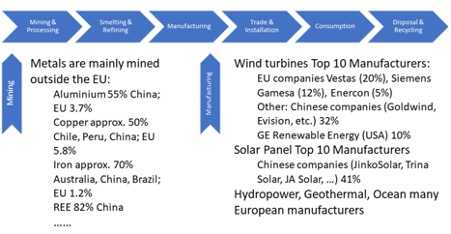Advancing responsible sourcing
in mineral value chains
The EU currently imports up to $300 million of oil, gas and coal per year to secure its energy supply. While importing these vast quantities of resources is proving to be insecure, especially in light of the current gas crisis, the burning of these fossil fuels is also proving to be unsustainable, accounting for 75% of greenhouse gases in the energy sector.
To reduce the impact on the climate, cut import costs and increase Europe’s autonomy, the EU wants to increase the share of renewable energy, such as solar panels and wind turbines, from the current 13% to 40% by 2030. But how can this be achieved, especially from a sustainability perspective?
The RE-SOURCING project provides a comprehensive answer to this question through a video (below) that outlines the roadmap to a sustainable renewable energy sector.This features interviews with experts in responsible sourcing and provides recommendations for policymakers, businesses, and civil society stakeholders on how to achieve this transition sustainably and helps to:
The RE-SOURCING project focuses on wind and solar PV energy and their respective supply chains, because of their importance for future energy supply. The project assesses three stages of the supply chain:
With the predicted capacity expansion of renewable energies, the demand for certain raw materials is expected to considerably increase. This will lead to several challenges, including:

The research team will be focusing on the mining and manufacturing segments of the renewable energy value chain.
The research team will focus on materials required for the energy transition. This includes traditional metals (mainly copper), as well as green tech minerals (e.g. rare earth elements).
There are a plethora of RS standards, guidelines and process that are being used to address identified RS challenges for the renewable energy sector. These existing standards and sustainability schemes, particularly for the mining sector are very comprehensive, but do not contain measures for all the problems that exist in the sector. However, it is acknowledged that difficult for one standard to cover all challenges. This page provides a summary of the more commonly found standards.

For a description of these standards and initiatives, see Existing Approaches. For a more detailed overview on the different standards and initiatives, see Chapter 3 of the State of Play & Roadmap Concepts: Renewable Energy Sector Report.
The mining sector has been the focus of many initiatives and voluntary standards to improve production practices and impacts caused by mining operations, including respect for human rights, prevention of conflicts, stakeholder management, or environmental protection.
Sustainability schemes and standards considered by RE-SOURCING Project, specifically for the mining stage include IRMA, ICMM, EITI, IFC EHS for Mining, The Copper Mark, ARM, Natural Resource Charter, World Bank Climate-smart mining, OECD Meaningful Stakeholder Engagement, GRI, EBRD and TSM.
For more details on these standards, see Chapter 3 of the State of Play & Roadmap Concepts: Renewable Energy Report.
The manufacturing of wind turbines and solar panels currently lack in international frameworks for EHS. Available standards consider the quality and technical specifications of the equipment, performance measurements and test procedures, monitoring and controlling systems, as well as design requirements.
Some countries have national guidelines, e.g., NSF/ANSI 457 “Sustainability Leadership Standard for Photovoltaic Modules and Photovoltaic Inverters” in the US. However, there are numerous guidelines currently under development. Two examples are:
• The American Wind Energy Association (AWEA) is developing technical, workforce, and environmental, health and safety standards
• EU Eco-design, Energy Label, Ecolabel, and Green Public Procurement for solar PV modules Some general standards and guidelines are also of relevance for this sector, e.g., ILO or IFC EHS guidelines
For more details on these standards, see Chapter 3 of the State of Play & Roadmap Concepts: Renewable Energy Sector Report.
For the collection and treatment of wind turbines general standards can be applied. For instance, the IEC EHS Guidelines for Wind Energy contain issues and recommendations related to the decommissioning of wind power plants. The German Institute for Standardization (DIN) developed the first industry standard for dismantling and recycling of wind turbines.
In some European countries there is a legislation in place forbidding composite materials from being landfilled. Others are considering introducing mandatory recycling rates for wind turbines.
Wind Europe set up a cross-sector platform to advance wind turbine recycling with specific focus on turbine blades. In addition, they are currently working on international guidelines for wind turbine dismantling and decommissioning.
For solar equipment, the best-known standard is the European directive on waste of electrical and electronic equipment (WEEE directive). This directive includes a section on photovoltaic panels and provides a framework for collection, transport, and treatment of photovoltaic panels on the notion of extended producer responsibility
For more details on these standards, see Chapter 3 of the State of Play & Roadmap Concepts: Renewable Energy Report.